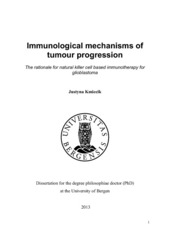| dc.contributor.author | Kmiecik, Justyna | en_US |
| dc.date.accessioned | 2014-01-14T10:21:25Z | |
| dc.date.available | 2014-01-14T10:21:25Z | |
| dc.date.issued | 2013-10-04 | eng |
| dc.identifier.isbn | 978-82-308-2388-0 | en_US |
| dc.identifier.uri | https://hdl.handle.net/1956/7670 | |
| dc.description.abstract | Glioblastoma (GBM) is the most frequent and malignant brain tumour, where the patients’ median survival after diagnosis is only 14.6 months. Therefore, concerted research is required to develop novel treatments that will improve patients’ outcome. Immunotherapy is one of the promising strategies for novel treatment. However, GBM develops multiple mechanisms of immune suppression and escape from immune surveillance. Moreover, steroids, chemotherapy and radiotherapy render GBM patients immunocompromised. These aspects need to be taken into consideration prior to development of immunotherapy tailored to GBM patients. Natural killer (NK) cells are large, granular lymphocytes that are able to recognise and kill tumour cells and virus – infected cells without prior sensitization and costimulation. Therefore, they might be one of the most potent effectors for use in an immunotherapy. However, there is currently a great paucity of studies investigating their potential as therapeutic agents for GBM. This study confirmed the prognostic significance of elevated T cell infiltration into the tumour in GBM patients. However, NK cells represented a minor population in the tumour microenvironment. Several mechanisms of the tumour’s escape from immune attack were identified, including the induction of a novel population of CD8+CD28- Foxp3+ regulatory T cells and expression of CD73 and CD39 ectonucleotidases. Tumour cells expressed classical HLA class I molecules that are ligands for inhibitory killer immunoglobulin-like receptors (KIRs) mediating NK cells tolerance towards self cells. Tumour infiltrating macrophages/microglia displayed phenotypic features that were indicative of their tolerisation by the CD8+CD28-Foxp3+ regulatory T cells. These features include: (1) down-regulated expression of CD40, CD80 and CD86 costimulatory molecules and (2) up-regulated expression of immunoglobulin-like transcripts 2, 3, 4 (ILT2,3,4). In the systemic circulation, decreased T helper (Th) cells, up-regulated expression of the inhibitory receptor CTLA-4 on the Th cells and increased plasma concentration of IL-10 were identified in GBM patients’ blood compared to healthy controls. Despite these integrated mechanisms of tolerance and immunological escape, a proportion of the tumour cells might be susceptible to immune cell – mediated cytotoxicity due to their expression of Fas ligand, and MICA stress – induced ligand for NK cell NKG2D activating receptor. Thus, taking into consideration the GBM patients’ local and systemic immune suppression and escape, we hypothesised that the use of allogeneic NK cells in a KIR receptor – HLA ligand mismatch setting might be an amenable strategy against GBM cells. We demonstrated that allogeneic, ex vivo cultured NK cells efficiently lysed GBM cells in vitro and in vivo. However, the NK cell efficacy was donor – dependent. The presence of KIR2DS2 and KIR2DS4 genes in donors’ NK cells correlated with increased cytotoxicity in vitro and this effect was partially independent of the inhibitory KIR genes repertoire. Intracranial injection of a single dose of 106 allogeneic ex vivo cultured NK cells improved the survival of GBM – bearing mice compared to controls. NK cells obtained from donor possessing KIR2DS2 and KIR2DS4 genes were more effective than NK cells missing these genes and manifested in prolonged animals’ median survival, increased tumour cell apoptosis, decreased proliferation and diminished angiogenesis. In contrast, treatment with double doses of 106 NK cells from each donor did not result in improved survival. We observed increased recruitment of macrophages into the brain parenchyma of all NK cell treated animals compared to controls. However, the animals receiving single dose of NK cells exhibited higher proportions of F4/80+ macrophages that expressed the IL-7 receptor (CD127), while higher proportions of microglia expressed CD40 co-stimulatory molecules compared to control group. The tumour cells up-regulated the expression of nestin and HLA-ABC after single dose NK cell treatment as a response to inflammation. In summary, this work provides the rationale for using allogeneic NK cells against GBM and indicates possible targets for adjuvant immunotherapy, such as the CTLA-4 inhibitory receptor and the targets of CD8+CD28-Foxp3+ regulatory T cells – induced immunotolerisation. Moreover, the results of the effect of KIR2DS2 and KIR2DS4 in NK cell – mediated cytotoxicity against GBM provide a novel insight into tumour immunology. However, further research is required to evaluate the safety and efficacy of allogeneic NK cell – based therapy and to confirm the role of activating KIR receptors in determining the potency of NK cells against solid tumours. | en_US |
| dc.language.iso | eng | eng |
| dc.publisher | The University of Bergen | eng |
| dc.relation.haspart | Paper I: Kmiecik J., Poli A., Brons N.H.C., Waha A., Eide, G.E., Enger P.Ø., Zimmer J. and Chekenya M. Elevated CD3+ and CD8+ tumor-infiltrating immune cells correlates with prolonged survival in glioblastoma patients despite integrated immunosuppressive mechanisms in the tumor microenvironment and at the systemic level. Journal of Neuroimmunology. 2013, 264(1-2):71–83. The article is available at: <a href="http://hdl.handle.net/1956/7668" target="blank">http://hdl.handle.net/1956/7668</a> | en_US |
| dc.relation.haspart | Paper II: Kmiecik J., Zimmer J. and Chekenya M. Natural Killer cells in intracranial neoplasms: presence and therapeutic efficacy against brain tumours. Journal of Neuro-Oncology. 2014, 116(1):1-9. The article is available at: <a href="http://hdl.handle.net/1956/7669" target="blank">http://hdl.handle.net/1956/7669</a> | en_US |
| dc.relation.haspart | Paper III: Gras Navarro A., Kmiecik J., Zelkowski M., Leiss L., Zimmer J. and Chekenya M. Activated NK cells are potent effectors against glioblastoma cells due to activating KIRHLA ligand interactions in vitro. Submitted. The article is not available in BORA. | en_US |
| dc.relation.haspart | Paper IV: Kmiecik J., Grass Navarro A., Enger P.Ø., Zimmer J. and Chekenya M. Purified and activated allogeneic NK cells efficiently kill human glioblastoma in vivo. Manuscript. The article is not available in BORA. | en_US |
| dc.title | Immunological mechanisms of tumour progression. The rationale for natural killer cell based immunotherapy for glioblastoma | en_US |
| dc.type | Doctoral thesis | |
| dc.rights.holder | Copyright the author. All rights reserved | |
